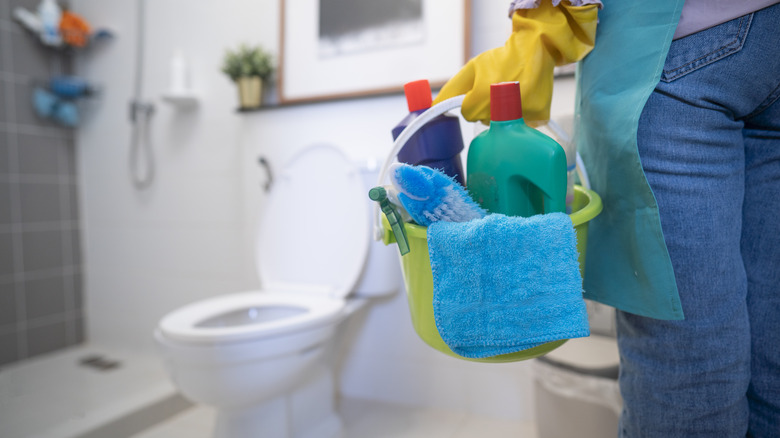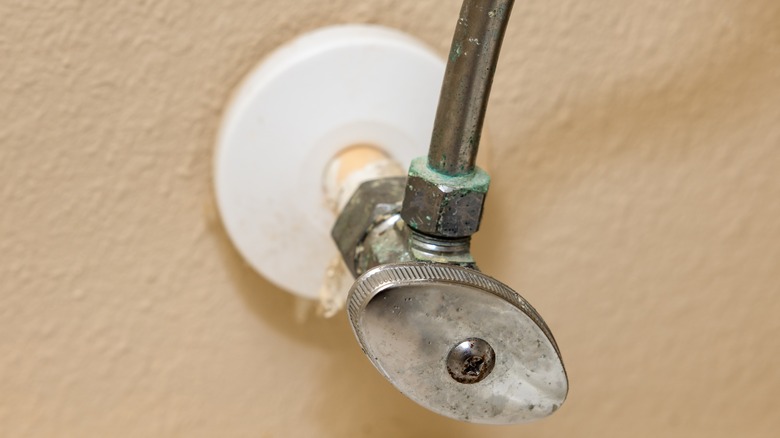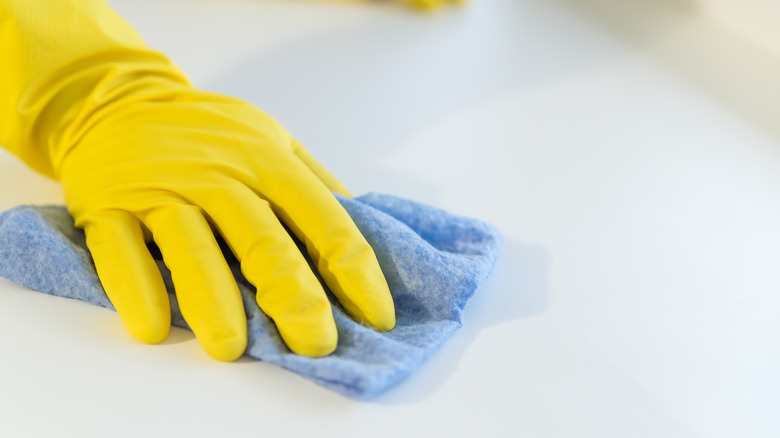Take These Essential Steps When Cleaning Up After A Toilet Overflow
There's nothing quite like the panic and dread caused by an overflowing toilet. It can be a big mess to clean up — not to mention the ick factor of dealing with waste. Cleaning up after a toilet overflow consists of a few basic steps: removing the wastewater, disinfecting the area, and drying it out.
Toilet overflows can be caused by a number of things, including clogs in the toilet drain, toilet trap, or sewage line. Flushing the wrong thing down the toilet, such as a diaper or paper towel, can result in a clog. A faulty fill valve, float, or vent pipe can also lead to a toilet overflow, as well as a malfunctioning septic tank. While diagnosing the exact issue is important to prevent future overflows, your biggest concern in the moment is likely just stopping the flow and cleaning it up.
Before you start, gather your supplies: a plunger with a flange or rubber bell, an auger or drain snake, buckets, towels, bleach, and a wet/dry vacuum if you have one. You'll also need gloves, a mask, and goggles to protect yourself from germs.
How to stop the overflow
To quickly stop your toilet from overflowing, you need to stop the flow of water to your toilet. One option is to turn off the water valve, which is typically located under the toilet near the wall. Turn the knob until you meet resistance or hear the water flow stop. Alternatively, you can take off the toilet tank lid, push down on the rubber flapper at the bottom of the tank, and lift up the float. Do this at the same time as turning off the valve if a second person is available. If you can't find your toilet valve, you can turn off the water supply to the entire house.
Next, put on your gloves, mask, and goggles. Use the plunger to dislodge any clogs and encourage the toilet to drain. Depending on how full the bowl is, you may want to skip the plunger and go straight to a toilet auger, which breaks up the clog and allows you to pull it out. If you don't have a toilet auger, try a drain snake. If none of this gets the toilet drain clear, call a professional for help sorting it out, and move on to cleaning up the bathroom.
Cleaning and disinfecting after a toilet overflow
It's important to clean up a toilet overflow quickly, as wastewater carries the risk of infection as well as water damage and mold growth. Still wearing your protective gear, use buckets to scoop up the fluid and dispose of it in the toilet (if you were able to get it cleared). Then soak up the remaining water with towels or a wet/dry vacuum. You can dispose of contaminated materials in the trash or wash them thoroughly afterward.
Then it's time to disinfect. Mix one cup of bleach with a gallon of warm water and scrub any areas that came into contact with wastewater using a clean cloth. Rinse each surface with clean water afterward. It's important to let the bathroom dry out fully after you're done; turn on the strongest fans you have to speed up the process. You may want to later follow up with another cleaner without bleach to get the bathroom smelling nice again. Don't forget to check the bathroom for water damage or mold growth, just in case.
Lastly, it's important to determine what was causing your toilet to overflow so you can address any plumbing issues and prevent future problems. You can also prevent future toilet clogs by flushing only toilet paper and waste down the toilet and keeping your toilet in tip-top shape with regular maintenance.


